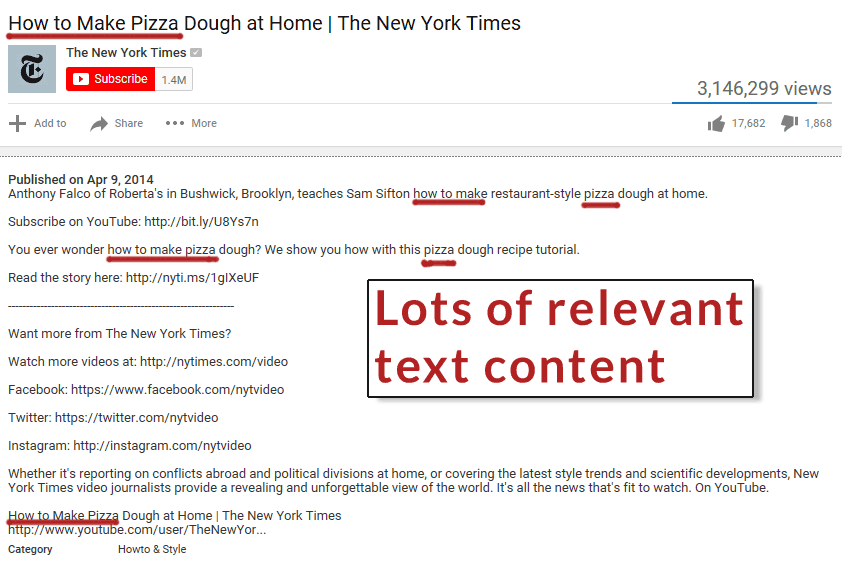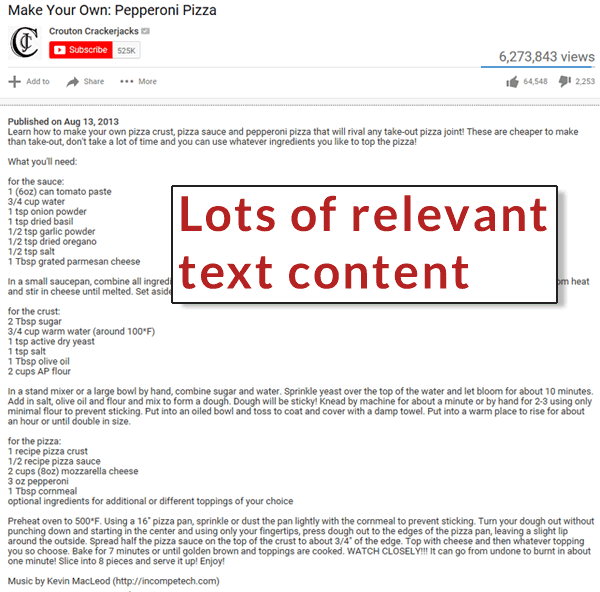RankRanger compared the ranking of video carousels in Google desktop versus how YouTube ranks. RankRanger discovered that the algorithm Google uses for desktop search is different from the YouTube algorithm.
This article goes beyond that study to identify possible reasons to explain that difference.
Search Algo Compared to YouTube Algo
For the keyword phrase [How to Make Pizza], YouTube appears to show videos that are popular on YouTube. The top 14 results in YouTube have millions of views. Showing users the most popular results is a good user experience.
Curiously, the number one ranked video, by BuzzFeed, has irrelevant text content:
 Top ranked video in YouTube features irrelevant text content. Could this be why it does not rank in Google’s desktop search carousel of videos?
Top ranked video in YouTube features irrelevant text content. Could this be why it does not rank in Google’s desktop search carousel of videos?The videos that are ranked by the YouTube algorithm may be based on features related to the videos themselves, on popularity, and user engagement metrics.
The length of the videos appear to be longer in YouTube rankings than in the Google desktop carousel. For the example search phrase, how to make pizza, Google even ranks a video that is forty two seconds long.
Is Google’s desktop video carousel algorithm showing a preference for shorter videos? Curiously, RankRanger’s study completely ignored this interesting metric.
Google’s Search Algorithm
The goal of the search algorithm is to satisfy the most people. Because a search query can have multiple user intents, Google’s search results can sometimes reflect that difference.
The different user intents can often be discerned by the different kinds of pages ranked in the search results. They are positioned in descending order of most popular user intent to the least popular.
Some search results rank well because certain web pages are popular and users expect to see those web pages. Some pages are ranked based on geographic proximity to the user. Both of those factors have nothing to do with anchor text or links. Those kinds of pages are ranked purely to satisfy user expectations.
Links, content, and popularity are some of the top reasons for why web pages appear in the search results. User satisfaction is an important reason for a web page or video to appear in Google’s search results. Many ranking studies do not (and can not) take user satisfaction into account.
Are Reasons for Ranking Differences Chaotic?
RankRanger’s study observed the differences in search positions between Google and YouTube. It ignored other factors such as popularity, subscribers, links, or even something as important as the length of the videos.
That may be why the author of the study was perplexed at the seeming randomness of differences between YouTube and Google Desktop rankings:
“The average rank of each Google carousel card’s YouTube ranking, whether it be the overall average, or, per category doesn’t really offer the full picture. That’s because the rankings are simply all over the place.”
The rankings appear to be all over the place because, as the study author admitted, they weren’t looking at the full picture.
Video Carousel Ranking in Desktop Search
Here is a screenshot of the video carousel for the phrase [How to Make Pizza], as displayed in desktop search:

If we take a look at that New York Times video result, you can see that there is relevant text content.
Perhaps more importantly, there is a lack of irrelevant textual content.
Quite likely there are citations and links to that video.

I believe it’s not a coincidence that the cooking and recipe sections of the New York Times exists on a subdomain, cooking.nytimes.com. It’s like having a standalone website for hosting recipe and cooking content.
Putting that content in a subdomain separates that recipe content from the rest of the site. This allows the New York times to create a more meaningful site architecture for the recipe and cooking content.
- That pizza recipe exists as a text recipe here: https://cooking.nytimes.com/recipes/1016230-robertas-pizza-dough
- And is featured in a category page about pizza recipes here: https://cooking.nytimes.com/68861692-nyt-cooking/807163-our-greatest-pizza-recipes
- That pizza recipe is also featured in this article: https://www.nytimes.com/2014/04/09/dining/a-little-pizza-homework.html
This appears to be significant promotion for that pizza recipe which can build demand for Cooking.NYTimes.com pizza recipes.
A side effect, in my experience, is that building awareness can cultivate traditional link and webpage signals, such as this link from a cooking site within an article about making pizza.
The second video in the carousel, also with several million views has relevant content on the video page itself.

The content creator is a popular cook and has a popular following with some blogs linking to it.
The third video in the carousel is by a highly popular online personality who started out as a pioneer YouTube star discussing makeup tips. The author of that video (Tanya Burr) is active on blogs and social media. Her Twitter account has over three million followers and her YouTube channel has over 3 million subscribers.
Her Facebook post about that pizza recipe received over two thousand likes.
 Facebook likes are not a ranking signal. However, Facebook engagement can be evidence of how popular something is.
Facebook likes are not a ranking signal. However, Facebook engagement can be evidence of how popular something is.I am not implying that Facebook helped that video rank. I’m certain it did not. I am citing the Facebook post as evidence that the video has been promoted and is in fact popular.
That is tangible evidence that a great many people enjoyed the video. It may be reasonably expected that many others will enjoy that video. User satisfaction is a strong reason for Google’s search engine to rank a web page or video.
That tangible evidence of popularity points to the fact that the video page may also be link worthy and tending to acquire links, which can assist with rankings. Here is an example of one of many web pages that link to that video:
 Web pages that are popular and useful tend to attract links. Links are an important ranking factor. Here’s an example of one of many links that this video has attracted.
Web pages that are popular and useful tend to attract links. Links are an important ranking factor. Here’s an example of one of many links that this video has attracted.Takeaway
Many ranking factor studies will be of limited use for understanding the reasons why sites rank the way they do. The RankRanger study focused on a limited set of factors that prohibited it from reaching any meaningful conclusions.
Data does not lie. But lack of meaningful data will offer a chaotic picture at best and false conclusions at worst.
With some understanding of how search engines tend to rank websites, one can, as I demonstrated above, discover interesting clues as to why Google Desktop rankings for Carousel videos differs from the rankings on YouTube.
You can read the RankRanger study here.
Images by Shutterstock, modified by Author.
Screenshots by Author





![AI Overviews: We Reverse-Engineered Them So You Don't Have To [+ What You Need To Do Next]](https://www.searchenginejournal.com/wp-content/uploads/2025/04/sidebar1x-455.png)